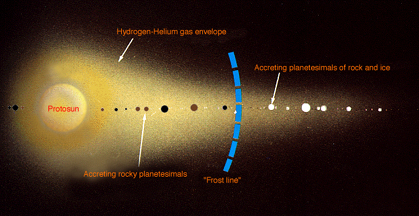This drawing depicts a position where the formation of ice became important.
Click on image for full size
Windows Original
The position of Uranus when gas changed to ice
The position of the planets in the solar nebula greatly affected their 1. size and 2. composition. This is because of the effect of how cold it was in the nebula.
1. The nebula was a lot warmer close to the proto-sun. The blue line shown in the picture shows the point at which the temperature became cold enough for gases to become ice. At this point and further out, the materials that forming planets (proto-planets) began to extract from the cloud were ice, as well as rocky material and gas molecules. Retention of ice resulted in these proto-planets becoming giant, massive planets. (The same thing happens to raindrops when it becomes cold enough for the raindrops to become slushy snow drops, the drops are more massive). Planets which formed closer to the proto-sun were smaller, and more rocky.
Uranus was farther out in the nebula, however, where the cloud was not only becoming colder, but becoming thinner as well. This meant that there was less gas to sweep up, so proto-Uranus was not able to sweep up as much gas as the proto-Jupiter. Thus Uranus is much smaller than Jupiter.
2. Uranus (unlike Jupiter) is made of complex molecules, and not a simple molecule like hydrogen. That is because near the proto-Uranus, the temperature was so cold that even methane and ammonia, which normally would drift away, solidified into ice and were drawn to the forming planet.
You might also be interested in:
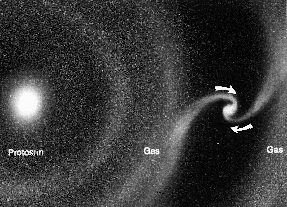
As shown in this picture, while they were forming in the solar nebula, the nucleii of the planets-to-be (called protoplanets) drew material to themselves from the cloud of gas and dust around them. The
...more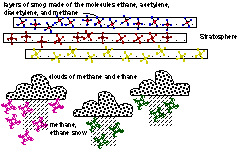
Besides methane, Uranus' atmosphere contains more sophisticated atmospheric molecules such as ethane gas, acetylene, and diacetylene. All these molecules form layers of haze at different altitudes high
...more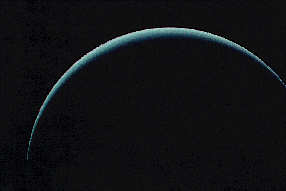
The mesosphere of Uranus is a region of balance between warming and cooling. That essentially means that nothing happens there. Except for diffusion, the atmosphere is still. Upper reaches of the atmosphere,
...more
As on Earth, the atmosphere of Uranus consists of a troposphere, stratosphere, mesosphere, and thermosphere. The troposphere is the region where the visible clouds are to be found. The stratosphere, as
...more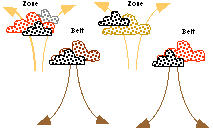
On Uranus, as on Jupiter, the winds in the belts and zones blow first in one direction, then in the opposite direction. Wind blows east in a belt, and west in a zone. The clouds rise up in a belt, and
...more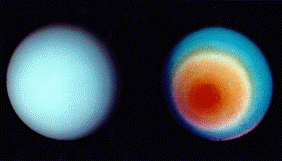
The striped cloud bands on Uranus, like Jupiter, are divided into belts and zones. On Uranus the belts and zones are hard to distinquish. The left picture shows the north pole of Uranus. In this picture
...more
The clouds of Uranus, composed of methane crystals, are found very low in the troposphere, and are difficult to distinquish below the smog haz es of the planet's atmosphere. False color is used, in the
...more


